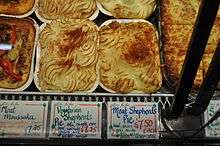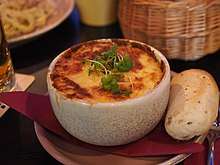Shepherd's pie
Shepherd's pie, cottage pie, or hachis Parmentier is a ground meat pie with a crust or topping of mashed potato of English origin.[2][3][4][5][6][7]
 | |
| Type | Meat pie |
|---|---|
| Place of origin | England |
| Region or state | Western Europe |
| Main ingredients | Mashed potato crust and meat filling |
| Variations | Cumberland pie, Shepherdless pie |

Louis Diat, 1946[1]
The recipe has many variations, but the defining ingredients are ground red meat cooked in a gravy or sauce with onions, and topped with a layer of mashed potato before it is baked. Sometimes other vegetables are added to the filling, such as peas, sweetcorn, celery or carrots. The pie is sometimes also gratineed with grated cheese to create a layer of melted cheese on top.
Etymology
The term cottage pie was in use by 1791,[3][8] when the potato was being introduced as an edible crop affordable for the poor (cf. "cottage", meaning a modest dwelling for rural workers).
The term shepherd's pie did not appear until 1854,[3] and was initially used synonymously with cottage pie, regardless of whether the meat was beef or mutton.[2][5][9][10][11][12][13][14] However, in the UK since the 20th century, the term shepherd's pie is used more commonly when the meat is lamb.[15][16][17]
The French name hachis Parmentier is documented in French in 1900,[18] and in English in 1898.[19] A hachis is anything finely chopped;[20] the English word 'hash' is borrowed from it.[21] 'Parmentier' is Antoine-Augustin Parmentier, after whom many potato dishes were named, as he was instrumental in the promotion of the potato in France in the 18th century.
History
In early cookery books, the dish was a means of using leftover roasted meat of any kind, and the pie dish was lined on the sides and bottom with mashed potato, as well as having a mashed potato crust on top.[10][11]
In France, hachis Parmentier was a "commonplace" and "homely" dish of the cuisine bourgeoise, which was nonetheless given place of honor at a Culinary Exhibition in Paris.[19]
Hachis parmentier is an economical way of using leftover meat, especially from pot-au-feu. Henri-Paul Pellaprat lists it in his section on leftovers,[22] as does the "bible" of bourgeois cuisine, Mme. St-Ange, under the name hachis de bœuf au gratin.[23]
A more elaborate version in 1921 by Auguste Escoffier consisted of a baked potato whose contents were emptied, mixed with diced meat and sauce lyonnaise, and returned to the potato shells or skins to be baked.[24] This version is rarely encountered.
Variations and similar dishes
Other potato-topped pies include:
- The modern Cumberland pie is a version with either beef or lamb and a layer of breadcrumbs and cheese on top. In medieval times, and modern-day Cumbria, the pastry crust had a filling of meat with fruits and spices.[25]
- In Quebec, a variation on the cottage pie is called Pâté chinois. It is made with ground beef on the bottom layer, canned (creamed) sweetcorn in the middle, and mashed potato on top.
- The shepherdless pie is a vegetarian version made without meat, or a vegan version made without meat and dairy.[26]
- In the Netherlands, a very similar dish called philosopher's stew (Dutch: filosoof) often adds ingredients like beans, apples, prunes, or apple sauce.[27]
- In Brazil, a dish called in Portuguese: escondidinho (hidden) refers to the fact that a manioc puree hides a layer of sun-dried meat. The dish often includes cheese and chicken or cod is sometimes used instead of beef.[28]
- A St. Stephen's Day pie is made with turkey and ham.[29]
- Fish pie is another part of English cuisine, made of fish and seafood in a béchamel sauce all topped with mashed potato.
- In Irish this dish is known as pióg an aoire.[30]
- In Argentina a similar dish is known as "pastel de papa" (Potato pie)
- In Uruguay a similar dish is known as "pastel de carne" (Meat pie)
- In Indonesia a similar dish is known as "pastel tutup" (closed pie), and is usually made with chicken and several vegetables such as carrot, green peas and boiled eggs, all topped with mashed potatoes.
See also
References
| Wikimedia Commons has media related to Cottage pie. |
| Wikibooks Cookbook has a recipe/module on |
- Diat, Louis (1946). French Cooking for Americans. Philadelphia: J.B. Lippincott Company. p. 85. OCLC 1036371103.
- The Oxford English Dictionary, Second Edition, Oxford University Press, 1933
- "shepherd's pie". Merriam-Webster. Retrieved 17 April 2018.
- "The Chambers Dictionary", Chambers Harrap Publishers Ltd, 1999
- Concise Oxford English Dictionary, Eleventh Edition (Revised), Oxford University Press, 2006
- "Jewish Cookery by Florence Greenberg", Penguin Books Ltd, 1947–1963
- Robert-Collins Dictionnaire Français-Anglais Anglais-Français, Nouvelle Édition
- "Home : Oxford English Dictionary". Retrieved 7 December 2015.
- The Glutton's Glossary: A Dictionary of Food and Drink Terms. Routledge. 1990. ISBN 9780415026475. Retrieved 20 January 2009.
- Mrs Beeton's Book of Household Management by Isabella Beeton, recipe 1427 in 1907 edition. Uses beef or mutton. Recipe not in original 1861 edition.
- Cassell's New Universal Cookery Book by Lizzie Heritage published by Cassell and Company, 1894
- Spry, Constance; Hume, J M Dent & Sons, 1956, Rosemary. The Constance Spry Cookery Book.CS1 maint: multiple names: authors list (link)
- Mrs Beeton’s Everyday Cookery, editor Susan Dixon, published by Ward Lock Limited, London, 1982, page 145, Shepherd’s Pie made with beef
- Chambers Dictionary, Ninth Edition, published by Chambers Harrap Publishing Ltd, 2003
- "Delia Smith: Shepherds Pie with Crusted Leeks". Retrieved 24 January 2009.
- "BBC Food Recipes: Shepherd's Pie". Retrieved 1 October 2011.
- "Shepherds' Pie and Cottage Pie". Retrieved 24 January 2009.
- Maurice Letulle, "Cure d'alimentation pour les tuberculeux à l'hôpital" (June 8, 1900), Bulletins et mémoires de la Société Médicale des Hôpitaux de Paris, Paris 1900, p. 712
- Ninet, Marguerite (April 1898). Cookery Exhibits in Paris. The Epicure: A Journal of Taste. 5. p. 194.
- Trésor de la langue française informatisé, s.v.
- Oxford English Dictionary s.v.
- Henri-Paul Pellaprat, "L'art d'accommoder les restes", Le Nouveau Guide Culinaire, Éditions René Kramer S.A. Lausanne, 1968, p. 189
- "Les restes", La cuisine de Madame E. Saint-Ange, Ed. Chaix, Grenoble, 1978, p. 421
- Auguste Escoffier, Le Guide Culinaire, Flammarion, 1921, p. 460
- "What is Cumberland Pie?". Retrieved 6 December 2010.
- "10 Things you didn't know about Shepherd's Pie - Jamie Oliver". jamieoliver.com. Retrieved 7 January 2020.
- "Filosoof - Mycitycuisine.org". www.mycitycuisine.org. Retrieved 28 August 2018.
- "Escondidinho recipe — Brazilian Wave". Brazilian Wave. 1 August 2012. Retrieved 28 August 2018.
- "BBC - Food - Recipes : Turkey and ham pie". Retrieved 7 December 2015.
- "cottage pie - Aistriúchán Gaeilge ar cottage pie (An Foclóir Nua Béarla-Gaeilge)". www.focloir.ie (in Irish). Retrieved 29 August 2018.
